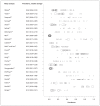Variation of a test's sensitivity and specificity with disease prevalence
- PMID: 23798453
- PMCID: PMC3735771
- DOI: 10.1503/cmaj.121286
Variation of a test's sensitivity and specificity with disease prevalence
Abstract
Background: Anecdotal evidence suggests that the sensitivity and specificity of a diagnostic test may vary with disease prevalence. Our objective was to investigate the associations between disease prevalence and test sensitivity and specificity using studies of diagnostic accuracy.
Methods: We used data from 23 meta-analyses, each of which included 10-39 studies (416 total). The median prevalence per review ranged from 1% to 77%. We evaluated the effects of prevalence on sensitivity and specificity using a bivariate random-effects model for each meta-analysis, with prevalence as a covariate. We estimated the overall effect of prevalence by pooling the effects using the inverse variance method.
Results: Within a given review, a change in prevalence from the lowest to highest value resulted in a corresponding change in sensitivity or specificity from 0 to 40 percentage points. This effect was statistically significant (p < 0.05) for either sensitivity or specificity in 8 meta-analyses (35%). Overall, specificity tended to be lower with higher disease prevalence; there was no such systematic effect for sensitivity.
Interpretation: The sensitivity and specificity of a test often vary with disease prevalence; this effect is likely to be the result of mechanisms, such as patient spectrum, that affect prevalence, sensitivity and specificity. Because it may be difficult to identify such mechanisms, clinicians should use prevalence as a guide when selecting studies that most closely match their situation.
Figures



Similar articles
-
[Comparison of simple pooling and bivariate model used in meta-analyses of diagnostic test accuracy published in Chinese journals].Beijing Da Xue Xue Bao Yi Xue Ban. 2015 Jun 18;47(3):483-8. Beijing Da Xue Xue Bao Yi Xue Ban. 2015. PMID: 26080880 Chinese.
-
A methodological review of how heterogeneity has been examined in systematic reviews of diagnostic test accuracy.Health Technol Assess. 2005 Mar;9(12):1-113, iii. doi: 10.3310/hta9120. Health Technol Assess. 2005. PMID: 15774235 Review.
-
The association of sensitivity and specificity with disease prevalence: analysis of 6909 studies of diagnostic test accuracy.CMAJ. 2023 Jul 17;195(27):E925-E931. doi: 10.1503/cmaj.221802. CMAJ. 2023. PMID: 37460126 Free PMC article.
-
Diagnostic test accuracy may vary with prevalence: implications for evidence-based diagnosis.J Clin Epidemiol. 2009 Jan;62(1):5-12. doi: 10.1016/j.jclinepi.2008.04.007. Epub 2008 Sep 7. J Clin Epidemiol. 2009. PMID: 18778913 Review.
-
The evaluation of diagnostic tests: evidence on technical and diagnostic accuracy, impact on patient outcome and cost-effectiveness is needed.J Clin Epidemiol. 2007 Nov;60(11):1116-22. doi: 10.1016/j.jclinepi.2007.03.015. Epub 2007 Aug 29. J Clin Epidemiol. 2007. PMID: 17938052 Review.
Cited by
-
Novel application of one-step pooled molecular testing and maximum likelihood approaches to estimate the prevalence of malaria parasitaemia among rapid diagnostic test negative samples in western Kenya.Malar J. 2022 Nov 6;21(1):319. doi: 10.1186/s12936-022-04323-2. Malar J. 2022. PMID: 36336700 Free PMC article.
-
Diagnostic Accuracy of an At-Home, Rapid Self-test for Influenza: Prospective Comparative Accuracy Study.JMIR Public Health Surveill. 2022 Feb 22;8(2):e28268. doi: 10.2196/28268. JMIR Public Health Surveill. 2022. PMID: 35191852 Free PMC article.
-
Rational development and application of biomarkers in the field of autoimmunity: A conceptual framework guiding clinicians and researchers.J Transl Autoimmun. 2022 Mar 6;5:100151. doi: 10.1016/j.jtauto.2022.100151. eCollection 2022. J Transl Autoimmun. 2022. PMID: 35309737 Free PMC article. Review.
-
Detection of atrial fibrillation in primary care with radial pulse palpation, electronic blood pressure measurement and handheld single-lead electrocardiography: a diagnostic accuracy study.BMJ Open. 2022 Jun 29;12(6):e059172. doi: 10.1136/bmjopen-2021-059172. BMJ Open. 2022. PMID: 35768092 Free PMC article. Clinical Trial.
-
C-reactive protein for late-onset sepsis diagnosis in very low birth weight infants.BMC Pediatr. 2018 Jan 30;18(1):16. doi: 10.1186/s12887-018-1002-5. BMC Pediatr. 2018. PMID: 29382319 Free PMC article.
References
-
- Straus SE, Richardson WS, Glasziou P, et al. Diagnosis and screening. In: Evidence-based medicine: how to practice and teach EBM. 3rd ed Oxford (UK): Elsevier; 2005:89–90
-
- Guyatt G, Sackett DL, Haynes RB. Evaluating diagnostic tests. In: Clinical epidemiology: how to do clinical practice research. Haynes RB, Sackett DL, Guyatt GH, et al. editors. New York (NY): Lippincott William and Wilkins; 2006:294–5
-
- Linden A. Measuring diagnostic and predictive accuracy in disease management: an introduction to receiver operating characteristic (ROC) analysis. J Eval Clin Pract 2006;12:132–9 - PubMed
-
- Scales CD, Jr, Dahm P, Sultan S, et al. How to use an article about a diagnostic test. J Urol 2008;180:469–76 - PubMed
Publication types
MeSH terms
LinkOut - more resources
Full Text Sources
Other Literature Sources
Medical
